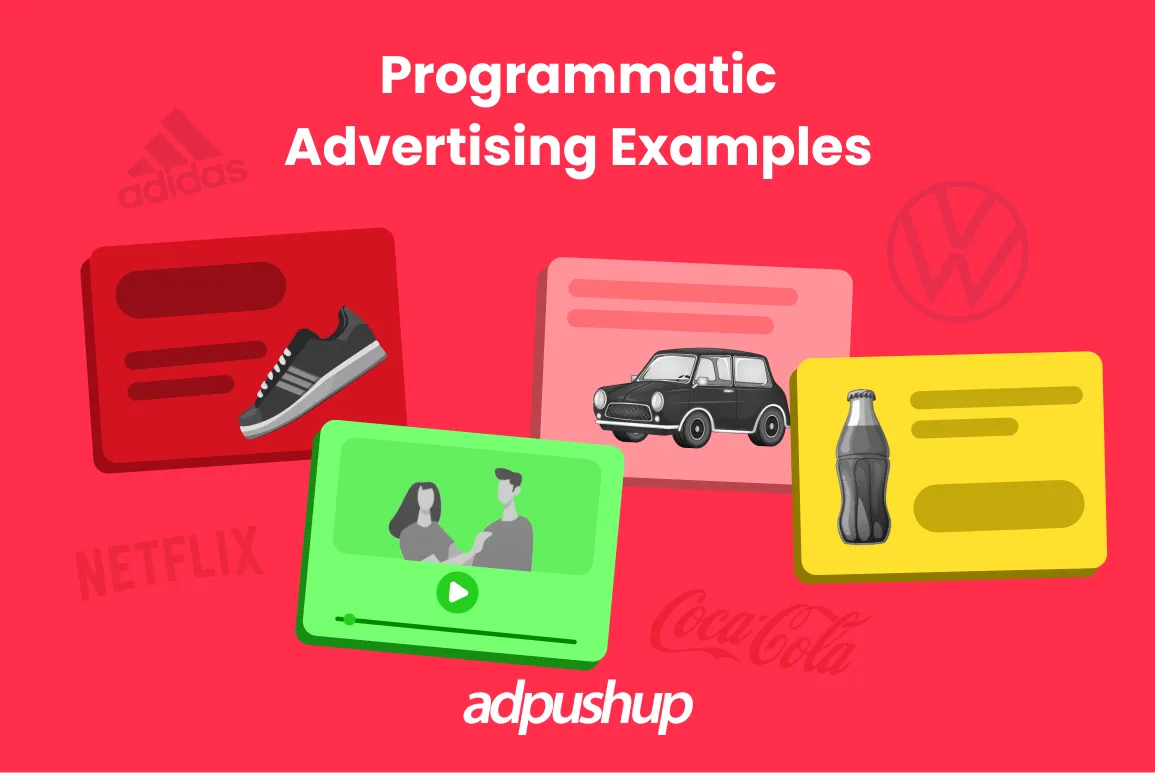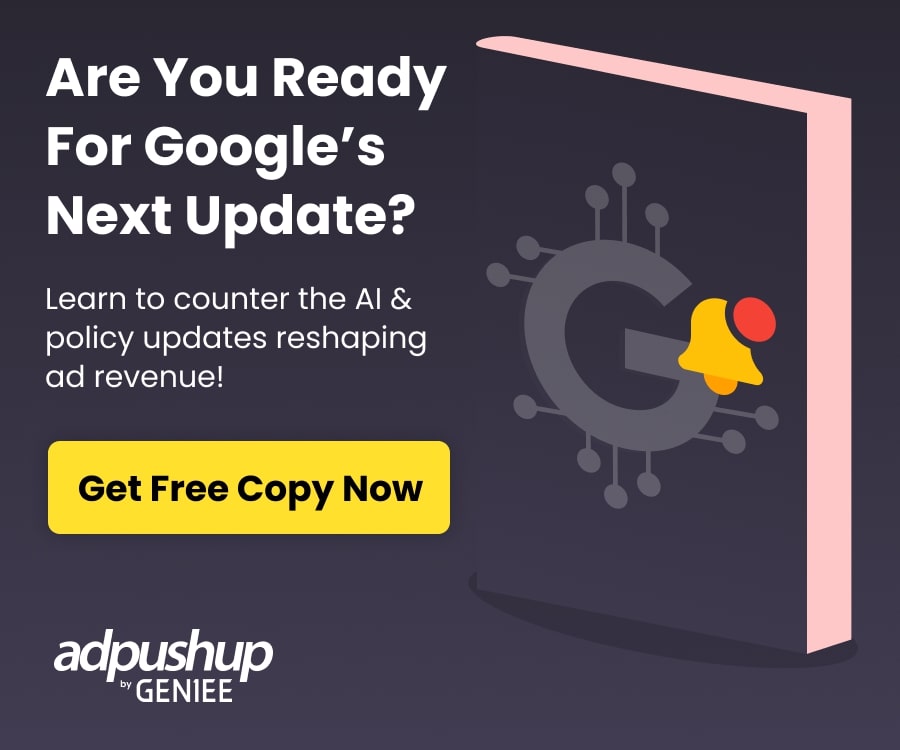Here are the top Programmatic Advertising Examples showcasing successful execution and results beyond expectations. The examples demonstrate how using innovative ad formats can heighten user engagement and deliver the desired results.
Programmatic advertising has become increasingly popular for businesses to reach their target audiences online. By leveraging data and automation technology, programmatic advertising allows advertisers to reach their desired audiences with precision and scale, resulting in higher engagement rates and better returns on investment.
In today’s digital age, businesses need to understand and leverage programmatic advertising to stay competitive in their industries.
By analyzing what made these campaigns successful and identifying key takeaways, we hope to provide valuable insights you can apply to your programmatic advertising efforts.
What is Programmatic Advertising?
Programmatic advertising is a form of online advertising that employs sophisticated algorithms to facilitate the transaction of ad space between the publisher and the advertiser. Its main motive is to serve ads to the right audience – at the right place and time.
Benefits of Programmatic Advertising
- Transparency: Provides publishers complete control and visibility over the ads running on their website.
- Real-time Measurement: Gives complete access to all the important data and metrics like CTR, impressions, conversions, bid prices, etc.
- Efficiency: Boosts efficiency by removing redundancy and automating the buying/selling process for ad space.
- Targeting: Places more focus on reaching the right audience rather than just ad placements.
10 Best Examples of Programmatic Advertising: An Overview for Publishers
Here are ten programmatic advertising examples that have been successful:
1. Spotify: 2.5x Increase in Engagement Rate with Personalized Audio Ads
Spotify, a music streaming application, functions both as a publisher/app developer and an advertiser. Through Spotify’s Self-Serve platform, the company indulges in programmatic audio advertising, which makes use of customized audio ads to drive website traffic and increase brand awareness.
Campaign Overview
Spotify continues to dominate the programmatic audio ad space by leveraging its vast user data. It focused on hyper-targeted, personalized audio ads based on a user’s listening habits, location, and interests.
Strategy
Spotify’s programmatic audio ads were dynamically tailored to match listeners’ preferences, showing ads relevant to their favorite genres, podcasts, or current moods. Ads were delivered in real time based on music trends or nearby events.
Results
Spotify saw a 2.5 times increase in ad engagement and retention, with brands reporting higher ad recall (25% increase) and conversion rates as audio ads seamlessly integrated into the user’s experience. Moreover, Spotify was also able to reduce its cost per acquisition by 20%.
The ingenious use of programmatic audio ads by Spotify to broaden a lesser-explored advertising niche makes it one of the finest examples of programmatic advertising.
2. McDonald’s: 28% Increase in Engagement Rate with Dynamic Video Ads
Let’s come to one of the finest examples of programmatic advertising in FMCG world. In 2023, McDonald’s launched the ‘Raise your Arches’ campaign. Unlike other campaigns, the ads under the campaign did not feature any of its products. Rather, the ads were created to capture the emotion that a person would feel while thinking of McDonald’s.
The campaign played on the visual similarity between raised eyebrows and the golden arches as a subtle suggestion to go to the fast food restaurant.
Campaign Overview:
McDonald’s utilized programmatic advertising to dynamically update video ads across multiple platforms based on local weather conditions and user data.
While the campaign was primarily run on televisions, social media platforms like TikTok and Instagram were also targeted for serving personalized ads – becoming one of the programmatic display advertising examples.
Strategy:
If it were a hot day, McDonald’s ads would promote cold beverages like McFlurry or iced coffee, while rainy days would promote ads for comforting meals. The use of geolocation and weather targeting made these ads hyper-relevant to the users.
Results:
McDonald’s saw a 28% increase in engagement and conversion for weather-based ads, and users reported a higher level of ad recall due to the real-time relevance of the campaign. Moreover, it was voted as the most-liked campaign in the Cannes festival. The chain also saw a 7.5% increase in footfall and a 4.5% rise in sales at its physical outlets.
3. Coca-cola: 189% Uplift in sales using Programmatic Display Ads
Coca-Cola started including programmatic advertising in its broader digital advertising strategy after the success of ‘Share a Coke’ campaign. It then partnered with MediaMath to take the campaign to the next level.
In 2023, Coca-cola Singapore decided to opt for its first-ever lower-funnel campaign in partnership with FairPrice Group – one of the largest supermarkets in the country.
Campaign Overview:
Coca-Cola and the supermarket chain started a retail data partnership through a demand-side platform, which enables brands to run end-to-end campaigns. This allowed them to precisely reach and target FairPrice customer segments on some of the fastest-growing digital channels, including websites on the open internet, over-the-top, audio, and digital out-of-home.
Strategy:
Coca-Cola launched a retail data-driven campaign aimed at Singapore that would continue through the joyous Lunar New Year season in 2022–2023.
Using The Trade Desk’s platform, the campaign team targeted FairPrice customers who had bought Coca-Cola or other products from the company within the previous one to three months.
The conversion was tracked on The Trade Desk‘s platform when consumers used FairPrice’s website or app to make in-person or online purchases after clicking on Coca-Cola’s programmatic display advertisements.
Results:
The campaign led to a 189% uplift in sales. Moreover, a remarkable average conversion time of 12 hours from the first ad exposure to the point of purchase was also attained by the campaign.
4. Nike: Leveraged Location-based Weather Ads to Increase Sales
Nike is not new to programmatic advertising. It has employed programmatic advertising for many of its campaigns, like Reactland. Here, the brand used programmatic advertising to find potential customers for its React shoes and invited them to play games in the store to let them feel comfortable.
Moreover, Nike has also utilized augmented reality (AR) via Snapchat to let its customers explore Nike products.
Campaign Overview:
Nike utilized real-time weather data to display appropriate products to users. It ran adverts on the Weather Channel app, recommending weather gear based on local weather conditions.
Strategy:
Nike used AI to analyze user behavior across digital touchpoints, creating custom visuals and messages for each viewer. Based on user data and their location, ads would feature different weather-based gear and apparel by Nike.
Results:
The personalized, data-driven ads led to a significant increase in conversion rates, with Nike reporting an engagement rate beyond expectations compared to static ads.
5. Netflix: Boosts Viewership using Predictive Behavioural Targeting
Another one of the most impactful programmatic advertising examples in the list is from Netflix. The company regularly utilizes programmatic advertising to promote its shows to its viewers. For example, to promote its political drama House of Cards, Netflix identified users who have shown regular interest in this genre and targeted the ads towards them.
The ad serving based on the user’s interests led to higher viewership for House of Cards. The same strategy has been employed for series like Wednesday and Stranger things.
As a publisher, Netflix has joined hands with The Trade Desk, Google’s Display & Video 360, and Magnite who will join Microsoft as the main programmatic partners for advertisers.
Campaign Overview:
In many instances, Netflix has employed predictive behavioral targeting to identify the audience that is more likely to watch a particular show. Based on the data gathered, Netflix serves personalized ads to its users across platforms.
To give a boost to its advertising capabilities, Netflix has been partnering with top advertisers like Gucci, Google, Mercedes-Benz, LVMH, etc to run their programmatic campaigns on its platform.
Strategy:
With the aim to establish its publishing capabilities, Netflix introduced its ad-based subscription plan ($6.99) in September 2024 which was more affordable than its standard plan ($11.99).
Since then, Netflix has started showing ads to its users using predictive behavioral targeting. The loyal user base that Netflix has developed with its binge-worthy content allows it to set up 1:1 private marketplace deals, generating premium eCPM for their ad inventory.
Results:
Netflix saw the following results post its ad-based plan rollout:
- A 150% plus increase in upfront ad sales commitments.
- 50% more signups for its ad-supported service plans.
- 5 million subscribers added in Q3 2024.
- Q3 revenue touched $9.83 billion – 15% increase compared to previous year.
6. Paramount+: Gained 60.5M Impressions with Interactive Audio Ads
Here’s another impactful programmatic advertising example to take inspiration from. Amazon uses programmatic advertising to deliver personalized ads to their users based on their browsing and purchasing history. By analyzing user behavior and preferences data, Amazon can deliver highly targeted ads that are more likely to result in a purchase, resulting in increased sales and revenue.
Campaign Overview:
Paramount+ Originals employed Amazon’s Interactive Audio ads to promote its crime-thriller series The Chemistry of Death.
Strategy:
Paramount+ launched a Branded Experience with Alexa (BEA), in which viewers who heard or saw an Amazon commercial advertising the series were prompted to say, “Alexa, open The Chemistry of Death” to their Echo device.
With this voice command, a quiz was started, asking listeners to answer a series of questions covering anything from entomology to the rate at which a corpse decomposes after death.
Users who finished the quiz were asked by Alexa to set a reminder on their Echo device for the series’ premiere date.
Results:
The awareness campaign achieved the following results:
- 60.5 million impressions delivered.
- 66% of the target audience interacted with the experience for more than 90 seconds.
- Users described the experience as 2.6x more relevant.
- 88% higher ad recall rate.
7. Adidas: Increased Brand Awareness and In-store Footfall using DOOH Ads
Adidas is one of the top brands that actively experiment with programmatic advertising. In one of their latest campaigns, Adidas used DOOH ads to promote its newest running shoes in urban areas.
Campaign Overview:
Adidas utilized programmatic digital out-of-home (DOOH) ads, which were centered around an app that let runners compete for time between ad totems. These totems also doubled up for this as race start and finish checkpoints.
Strategy:
The Billboard Run encouraged runners to scan a QR code on a DOOH totem, with QR code tracking used to log each participant before they raced through the streets to a designated finish line display. The monitors showed the fastest times, and competitors won prizes such as Adidas gear.
Results:
Adidas saw significant interaction with its DOOH ads, leading to an increase in foot traffic to their stores during the campaign.
8. ABC Stout Beer: Achieved 86% Viewability through In-game Ads
Heineken, the parent company of ABC Stout Beer, has frequently indulged in programmatic advertising campaigns to advertise its products. The latest beer line by ABC Stout was no different.
ABC Extra Stout is considered to be an older people’s drink in Myanmar. Through its efforts, ABC wanted to make the drink popular amongst the younger generation as well.
Campaign Overview:
ABC Stout Beer Myanmar decided to opt for in-game ads as gaming has been a popular sport in the country. The campaign’s main goal was to penetrate the population bracket of 18-34 years.
Strategy:
ABC decided to go with in-game billboards rather than basic in-game ads. ABC designed the ads to blend in with the gaming environment. Their main aim was to increase brand awareness of ABC Extra Stout.
The ads were strategically placed to increase impressions and view time to create the maximum impact on the users.
Results:
The campaign was a huge success. ABC Extra Stout’s viewability touched 86%, 10% of the ads were clickable, and the CTR stood at 0.27%. The ads were also able to reach 68% of the target audience.
9. Volkswagen: Achieved 88% Listen-through rate using ShakeMe Audio Ads
Volkswagen has used programmatic advertising on many fronts to market its products, but the one we will be discussing here is quite different. To capture the Italian market, Volkswagen Italia employed an innovative ad format – the ShakeMe ads.
Campaign Overview:
Volkswagen intended to increase brand awareness and website traffic to its local Italian website for its van series of commercial vehicles by using audio in a novel and inventive way.
Strategy:
ShakeMe is an audio format that elicits instant action from app users, with a better conversion rate than standard audio or display advertisements.
While listening to an audio commercial, listeners can shake or touch their phones to download apps, access coupons, make calls, add calendar appointments, browse a website, or utilize voice commands, all without unlocking or glancing at their screens.
The audio format was delivered throughout Mediamond’s interactive radio stations, including Radio 101, Radio 105, and Virgin Radio, using AdsWizz‘s AdWave platform.
The advertising, which targeted listeners aged 25 and above as well as behavioral segments such as “car enthusiasts” and “in-market car buyers,” looked like automobile commercials, engaging viewers as they listened to music on their mobile apps while adding an interactive element.
Results:
Volkswagen achieved fantastic results, with over 3,000 engagements and an 88% LTR of all delivered ads. The LTR (listen-through rate) is the percentage of ad plays that were heard in their entirety.
The interactive aspect included in this specific radio campaign allowed VW to achieve a Shake CVR (conversion rate) of 0.97%.
10. Garnier India: Reached 21M+ Unique Audience using DV360
L’Oréal is one of the few beauty brands that has embraced programmatic advertising and augmented reality on a magnanimous scale. The brand has employed programmatic advertising on several occasions to promote its products.
In this case, we will be discussing one of L’Oréal’s brands – Garnier India, for programmatic advertising examples.
Campaign Overview:
Garnier India aimed to boost brand recall and consideration for Garnier Colour Naturals. Furthermore, it aimed to increase engagement and brand relevance among women aged 25 to 44.
Strategy:
It employed a combination of audience categories to determine 37 primary groupings in India’s top 35 cities. Using Studio, Google Web Designer, and Display & Video 360, the business was able to swiftly design and serve dynamic ad versions with targeted messages to various audiences in the appropriate context.
Results:
In just two weeks, the campaign attracted more than 21 million unique users. The brand’s dynamic display advertising increased ad recall by 42% and produced a 22% higher CTR than previous campaigns.
AdPushup: Programmatic Advertising Examples
AdPushup is a publisher-focused ad revenue optimization platform and a Google Certified Publishing Partner that works with more than 30 premium demand partners to serve the most relevant ads. A pioneer in A/B testing for ads, AdPushup has partnered with some of the most premium publishers to provide a guaranteed revenue boost by 40%.
Here are some of AdPushup’s programmatic ads examples:
1. CWBChicago
CWBChicago, a prominent US-based news website that has been running for eight years, approached AdPushup with the following queries:
- Improving monetization experience due to lack of personalized support
- Diversification of monetization avenues
- Maximizing ad revenue
Analyzing the business and the problems they faced, our ad ops team came up with the following solutions:
- Header bidding to allow premium advertisers access to their ad inventory
- Setup ActiveView Ad Refresh to capitalize on the high time on site by the visitors
- Implementation of video ads and other innovative ad formats
- A/B testing for ad layout optimization
Results:
- An Overall Revenue uplift rise of 101%
- An Impressions rise of 31%
- A RPM increase rise of 48%
2. RentLingo
RentLingo is a flat search service that offers users exclusive content on property listings and reviews. Their unique ‘Noise Index’ and ‘Charm Index’ distinguish them from market competitors by indicating how noisy and desirable a site is.
The company wasn’t looking specifically to increase its ad revenue – it only wanted to optimize its AdSense revenue. However, their major challenge was improving their ROI from revenue sources like ads and display ad optimization.
After a thorough review, our ad ops experts came up with two solutions: running advanced A/B testing with various ad sizes and deploying innovative ad placements without changing the website layout.
Results:
- 64.66% increase in AdSense Page RPM
- 115.3% increase in AdSense Page CTR
3. 1stRecipes
1stRecipes is a popular website for US cuisine and recipes. The website receives roughly 1 million monthly hits and offers a broad selection of world-renowned and easy-to-cook recipes, making it a must-visit destination for food fans all over the world.
By partnering with AdPushup, the website wanted to achieve the following goals:
- Increase ad revenue (website was under-monetized despite having premium ad inventory)
- Improve ad viewability
- Minimal impact on the user experience
Results:
- A 200% increase in ad revenue
Programmatic Ads Examples From Google
- Nestle UK utilized programmatic audio ads to position Nestle Kitkat Senses as a premium gift for family and friends, resulting in a 58% increase in incremental reach and the acquisition of a newer audience by 21%.
- Australia’s Qantas Airlines used Google DV 360 to deliver relevant and tailored ads to frequent flyers, resulting in a 57% increase in CTR and a 170% increase in conversion rates.
- Charlotte Tilbury Beauty reduced CPA or cost-per-acquisition by 20% by using DV 360 and a custom bidding strategy to optimize bids.
Summary and Key Points on Programmatic Advertising Examples
After discussing the top examples of programmatic advertising, we can identify some commonalities and key takeaways that can help guide future campaigns.
1. Personalization is Key
Personalization was a key factor in their success across all campaigns. By leveraging data and technology to deliver tailored messages to specific audiences, brands were able to increase engagement and drive conversions.
2. Creative Execution Matters
While personalization is important, it is not enough. The creative execution of the campaign also plays a crucial role in capturing the audience’s attention and driving engagement. Brands that created visually appealing and emotionally resonant ads were more likely to see success.
3. Testing And Optimization Are Crucial
All the above-mentioned campaigns employed a constant testing and optimization strategy. By analyzing data in real time and making changes to the campaign based on performance, brands could maximize their ROI and ensure that their messages resonate with their target audience.
4. Goals Should Be Specific and Measurable
Each campaign had specific goals, allowing the brands to track their progress and adjust their strategies as needed. It helped to ensure that the campaigns were aligned with overall business objectives and that resources were being used efficiently.
5. Adapting To New Technology Is Essential
Programmatic advertising is an ever-evolving field, and brands that can stay on top of new developments and adapt quickly are more likely to see success. It includes staying up-to-date on changes to ad platforms and targeting options, as well as the latest technology, like artificial intelligence and machine learning.
Got a minute? Take a look at how we delivered a 534% ad revenue uplift in 6 Months for CCNA7. If you want to learn how AdPushup can do the same for you, go ahead and request a demo. We’d be more than happy to help.
Frequently Asked Questions
Programmatic advertising uses software to automate the buying and selling of digital advertising. It involves using algorithms, data, and machine learning to target specific audiences and optimize real-time ad placement.
The benefits of programmatic advertising include increased efficiency, more precise targeting, and better ROI. Programmatic advertising can save time and money while delivering more relevant ads to the right audience by automating the buying and selling process.
Some challenges of programmatic advertising include ad fraud, brand safety concerns, and the need for transparency. Advertisers must work with trusted partners and employ effective fraud detection measures to minimize risk.
To get started with programmatic advertising, you’ll need to work with a demand-side platform (DSP) or advertising network that offers programmatic advertising capabilities. It’s also important to clearly understand your target audience and campaign goals before getting started.







